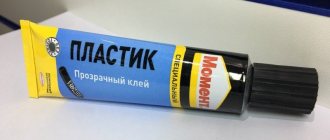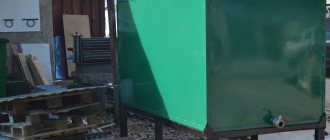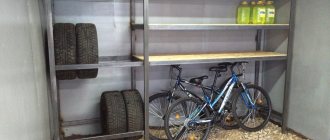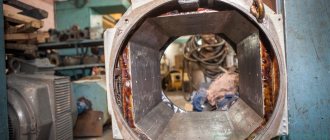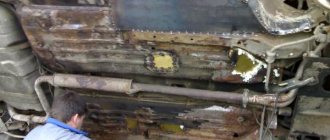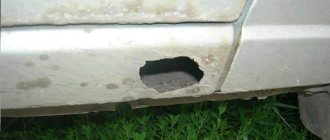Perhaps the biggest nuisance for the driver is a leak from the fuel tank. It is strictly contraindicated to continue driving with such a malfunction. And it’s not just about the loss of expensive fuel and the likelihood of it running out in the middle of a deserted highway. Gasoline ignites from a spark or contact with hot objects, which can lead to an explosion and fire of the vehicle.
The best option is to contact a workshop, but this is not always possible, and also costs money and time. There are many ways to repair a gas tank yourself, both in the garage and on the road. The choice is determined by the arsenal of materials and tools for repair, the characteristics of the breakdown and the design of the equipment.
How to brew a gasoline tank, a few rules
A leak in the gas tank occurs as a result of physical wear or due to damage with collapse of the housing. Fuel vapor accumulates in an empty tank, so welding and heating can cause an explosion. Many motorists ask how to properly seal a gas tank. There are several repair methods: argon arc and cold welding, soldering. Let's look at each of them in more detail.
General rules for repairing a gas tank
The presence of a leak is indicated by increased fuel consumption and a specific smell in the cabin. Even a minor crack is dangerous for the life of the driver and passengers. The leak area ignites when struck by a spark. Damage occurs as a result of cracking of the body during driving and exposure to corrosion. Defects occur when there is a malfunction in the vehicle's fuel system. The discharged pressure contributes to the gradual cracking of the walls. Microcracks gradually increase, causing leaks. Before welding the gas tank, you must follow the safety rules:
- be sure to drain gasoline or diesel fuel from the tank;
- thoroughly dry and dismantle the tank, inspect for damage;
- wash inside using specialized detergents;
- After washing with household chemicals, rinse thoroughly and dry.
Washing the tank allows you to completely remove explosive vapors. The repair method is selected based on the material from which the tank is made. Argon arc welding of a fuel tank is only suitable for metal containers; it is recommended to repair plastic products using cold welding; hot soldering is a universal method. Let's take a closer look at how to seal the gas tank yourself.
Cold welding gas tank repair
Cold welding is suitable for containers with hard plastic walls or for metal tanks. Glue does not adhere well to thin-walled tanks, so such repairs will be ineffective. The adhesive composition is selected in accordance with the type of container material. It is recommended to wear gloves when repairing a gas tank using cold welding. The crack is cleaned of contaminants and degreased with nefras.
Two-component mixtures are combined in the proportion specified by the manufacturer. The prepared solution must be used within 10-20 minutes depending on the brand name. The glue is applied to the damaged area in layers and smoothed, pressing it to the surface. 2-3 hours after repair, the tank is ready for use. The glue in the form of a bar is thoroughly kneaded with a damp hand and the crack is covered.
Cold Welding Selection
When choosing a cold weld, it is necessary to take into account that it must be resistant to gasoline. Only minor damage can be sealed with it. Moment superglue or similar special compounds from other manufacturers are perfect for eliminating leaks on the road. The rags are cut into patches, soaked in glue and attached to the hole in several layers. This repair method is temporary; it allows you to get home or to a service station and completely solder the holes.
To repair minor damage on your own, you can use epoxy resin with a hardener and fiberglass. The defect area is treated with sandpaper to increase adhesion. After the surface has dried, a glass cloth impregnated with resin is applied to the crack. Each subsequent layer is laid after the previous one has dried. After the last layer has hardened, the patch is treated with an anti-corrosion compound.
Soldering
Compared to cold welding, fuel tank soldering is more resistant to mechanical stress and external factors. To eliminate a leak, prepare a patch 4-5 cm larger than the area of damage. Repair of plastic products is carried out on the outer part of the walls of the gas tank with a 250-watt soldering iron. When sealing, you need to select a patch from the same material. The type of plastic is indicated on each part. Most often, gas tanks are made of ABS, polypropylene or polyamide.
For high-quality adhesion, a substrate of fine reinforcing mesh made of metal or copper is required. The substrate is fused into the wall of the gas tank, evenly distributing liquid plastic over the entire surface of the defect until a new uniform coating appears. The procedure is performed quickly so that the plastic does not harden, otherwise sagging will form.
In metal containers, you can seal the hole with a thin metal or copper patch. You can heat the case using a blowtorch or iron. The patch is attached with low-melting solder along the entire perimeter using a 500-watt soldering iron, having previously treated the joints with soldering acid. After soldering, you need to let the body cool, then cover the patched area with bitumen mastic or paint. The coating will protect the patch from corrosion.
Repair using electric welding
Welding a fuel tank using a argon arc welding machine and tungsten electrodes is considered the most reliable method. It reliably connects non-ferrous metal with alloy steel. Most gas tanks are made of aluminum, so inverter welding is not suitable for repairs. The repair area is cleaned of oils and dirt. The patch is welded around the entire perimeter, trying to maintain a homogeneous gas environment. The seam is smooth and durable. After cooling, the repaired area is painted or covered with bitumen mastic.
Plastic gas tank repair
Repair using epoxy glue is the fastest. This is a temporary measure to fix a leak along the way. You can patch the hole using a plastic welder - an extruder. Welding tanks using this method requires certain experience and knowledge of technology. It is recommended to practice on a small piece of plastic before welding. To correctly calculate the productivity of an extruder, you need to know the size of the cross-section of the crack. Welding begins from the edge of the fracture, laying the molten plastic welding wire evenly across the entire width of the hole with a small margin. For thorough welding, movements are made across the crack, completely filling the hole. In order for the seam to lie evenly, it is necessary that the hot air gun and the shoe of the device are evenly heated.
Repair using electric welding
Welding a fuel tank using a argon arc welding machine and tungsten electrodes is considered the most reliable method. It reliably connects non-ferrous metal with alloy steel. Most gas tanks are made of aluminum, so inverter welding is not suitable for repairs. The repair area is cleaned of oils and dirt. The patch is welded around the entire perimeter, trying to maintain a homogeneous gas environment. The seam is smooth and durable. After cooling, the repaired area is painted or covered with bitumen mastic.
Electric arc brewing
When making major repairs or eliminating significant holes, it is necessary to use traditional welding of the gas tank, which involves the use of special welding equipment.
The procedure for preparing for welding is as follows:
- first, the fuel is drained from the gas tank, for which the car is tilted to one side using a jack;
- then, using a drain tube, the remaining gasoline is removed from it;
- and at the end of the preparatory procedures, the gas tank itself is dried until the smell from the vapor completely disappears.
If the hole is very large, a solid piece of the gas tank is cut out at this location, and a patch of suitable size is welded in place of it.
You can weld the gas tank without removing it from the car. However, if the damage is located in a hard-to-reach area, it is unlikely that it will be possible to qualitatively repair it without removing it, so you should not even try to waste time and effort on such welding.
Another method worth mentioning is to quickly restore a damaged gas tank, which involves sealing the hole with epoxy resin and a piece of fiberglass.
However, this method can only be used for small punched holes and does not always achieve the required quality in the field.
So, like cold welding, it can only be classified as a temporary measure.
steam before soldering. Then prime inside and outside with protective primer, epoxy based.
Soldering itself is a sure thing
I would change it. Once I saw a cultivator burst into flames.
The outlet fitting was also snotty, they also coated it with cold welding.
Translate? What to steam?
That tank costs half a penny on market day :)
Features of eliminating leaks
Professionals recommend repairing the tank in services or special self-service boxes, where there are suitable conditions and tools.
Also, if you turn to a car service center for help, specialists will do the job efficiently and quickly. But if there is no trust in the hands of the craftsmen or a person does not have time to get to the repair point, then minor damage can be repaired independently.
To do this you need to do the following:
- Choose the right means and method for eliminating leaks. The glue must not be harmful to the tank and must be suitable for this material. The size of the crack plays an equally important role.
- In order for the repair to be high-quality and the fuel tank to last as long as possible, it is advisable to remove it from the car. You can do without disconnecting the hoses and removing the gas tank only when the oil product flows weakly and the damage is small.
- When using any of the fuel tank repair options, the surfaces must be prepared on both sides. The outside of the tank is cleaned with an iron brush and sandpaper, and the inside with detergents.
- When the adhesive has been applied, its remnants must be removed and the surface covered with a layer of protection.
- One of the most important steps is to check the gas tank for leaks after sealing the holes.
Causes of gas tank cracks
On most cars, the gas tank is located in the rear (right, left, under the rear seat). This design feature is explained by safety for passengers and the driver. In addition, vehicle handling is improved. However, the rear part of the body is quite often subject to external damage during vehicle operation, as a result of which the gas tank also suffers. The most common cause of cracks is mechanical stress leading to holes in the container. Considering the quality of Russian roads, sometimes even a slight impact is enough to cause a hole to form.
Significant causes of damage also include metal corrosion, which is an inevitable process. The more mileage a car has, the higher the likelihood of this type of problem. Less common are power system faults. Since a rarefied pressure is created in the middle of the tank as fuel is consumed, this affects the condition of its walls. During operation, small cracks may appear on them, and as a result of their enlargement, leakage occurs. This situation indicates the need to repair the gas tank.
One of the reasons for gas tank damage is corrosion.
What to do if your tank leaks
The appearance of a crack, hole or any other type of damage to the gas tank is typical not only for domestic cars, but also for foreign cars. When the seal of the tank is broken, it is necessary to fix the problem as soon as possible. Operating a vehicle with such a malfunction can lead to disastrous consequences, and danger threatens not only those in the car, but also those around them. Due to the fact that the fuel tank is a simple structure, restoring the tightness will not be difficult. However, much depends on the degree of damage and the feasibility of such an event. Since gas tanks are made of different materials, different repair methods are used.
How to check the tightness of a repaired tank
Before installing the repaired container in place, it is imperative to check its tightness. First, the part is subjected to an external inspection to identify damage and places where it may appear due to corrosion and wear. Then the tank is plugged and its integrity is checked.
This is done in the following ways:
- Filling with water. If there are holes, then these places become damp, trickles and drops appear there. For more reliable testing, the tank is subjected to vibration.
- Injecting compressed air. After pumping is completed, the container is covered with soap foam. Bubbles indicate the presence of holes.
When there are no problems, all that remains is to install the tank in place, secure it, and connect instruments and devices, taking precautions.
General rules for repairing a gas tank
If you discover a malfunction in the fuel tank, immediately turn off the car and turn off the ignition - high temperatures and electrical sparks can easily lead to the ignition of not only liquid fuel, but also its vapors. Armed with a flashlight, a soft brush and a rag, go look for a leak. Please note: brushes with metal bristles are strictly prohibited for any type of work near flammable materials. The further algorithm of actions is simple:
- Drain the fuel from the tank into a clean container of sufficient capacity . Determine the material of the part (hard or soft plastic, steel or aluminum).
- Inspect and feel the bottom and sides of the tank . A noticeable leak or barely perceptible moisture will indicate the approximate location of the breakdown.
- If the tank is damaged in a hard-to-reach place, remove it from the vehicle . In most cases, repairs can be made without removal.
- Using a soft brush, clean the damaged area and surrounding surfaces from road dirt, dust and salts.
- If necessary, remove material thinned by corrosion, burrs and chips ; Carefully trim the edges of chips and mother-in-law.
- Analyze the size and nature of the damage , and then decide on the feasibility and method of repair.
How to detect damage to the gas tank
Most vehicles have a fuel tank located on the bottom, which increases the risk of damage when driving over rough terrain or poor quality roads. A simple blow to the gas tank can cause a dent in it, but targeted pinpoint damage will result in a puncture. The following factors indicate that the gas tank is broken:
- The smell of gasoline began to be clearly felt inside the car;
- The fuel level needle began to approach zero faster than usual.
We recommend: DIY diesel engine turbine repair
If you notice signs of a breakdown in the gas tank, you should stop the car and turn off the engine. After this, carefully inspect the gas tank for damage and leaks. When they are found, you will need to act, depending on the specific situation. Below we present several ways to repair a fuel tank yourself in road conditions.
What is cold welding for metal
Cold welding for metal is a special composite polymer that has high adhesion to various materials (in this case, metals). In simple terms, cold welding is an adhesive that quickly hardens and does not react with motor oil, gasoline, diesel fuel and similar petroleum products.
Such products are divided into 2 types: liquid and plastic compositions.
- Liquid compositions are usually created on the basis of epoxy resin, which gradually hardens after entering into a chemical reaction with a hardener. A distinctive feature of the resin is the ability to combine it with various substrates and reinforcing elements (fiberglass, metal mesh), as well as the absence of emissions in the form of moisture, harmful substances or a strong odor.
- As for plastic compounds, these are special putties. They look like two-layer or two single-layer bars. Outwardly, they can easily be confused with simple children's plasticine.
After we have figured out what cold welding for metal is, we can move on to the next point of our educational program.
How to seal a plastic gas tank?
Most modern vehicles are equipped with gas tanks made of polymer composite materials. Such tanks are lighter, cheaper, have sufficient elasticity and immunity to chemical reagents. However, they also burst and break through, and urgent repair with your own hands is often the only way out of such a situation.
Crack in plastic gas tank
When considering the best way to seal a plastic gas tank, you can use one of the following methods:
- Soldering iron. If the crack is small, then melt its edges until a state of solidity and tightness is achieved. This method is unreliable, since the diffusion of the material occurs over a short distance. It is much more effective to apply a patch made of a similar polymer. The best result is achieved when a metal mesh is fused into the area of the hole, and a patch is soldered on top of it.
- Epoxy resin. The technology is absolutely similar to that used on metal products. The hole is closed with several strips of fiberglass soaked in the solution. The result is quite decent. Such repairs can withstand several years of use. The only thing is that you will have to wait a few hours, since the resin takes a long time to harden.
- Plastic welding. A homogeneous or two-component composition is used, which hardens after mixing, cooling and contact with air. The advantage is that the sticky mass can be given any shape, including with sagging on the inside. The main thing is to choose a product that has good adhesion to the gas tank material.
Taking into account the experience of numerous repairs of plastic containers, the craftsmen developed a recommendation to first stitch the edges of the cracks with metal wire. The seam prevents the edges from coming apart due to thermal deformation and shaking.
Features of working with plastic
It is easier to work with polymer tanks because they are softer and the melting point of plastic is lower. But there is also a certain peculiarity in this. Some reagents can melt the material, making further repairs difficult or impossible.
Soldering a plastic gas tank
Also, you need to be extremely careful with heat. Exceeding the permissible temperature and overexposure lead to deformation and the appearance of new damage. Therefore, deciding what to seal a plastic gas tank with must be balanced and thoughtful.
Metal gas tank
Metal tanks for storing fuel are not the most popular, but extremely reliable solution for vehicle technical equipment. First of all, this applies to trucks or certain brands of special passenger cars, since this category of transport is most susceptible to the risks of third-party mechanical impact during operation.
Most often, steel or aluminum, which have increased strength characteristics, are used for tank construction. However, this does not at all guarantee that in the event of a strong impact or due to the driver’s negligence, the tightness of the gas tank structure will remain unchanged. If an unpleasant incident occurs and the owner discovers a crack in the gas tank, he can try to fix the part with his own hands.
How to seal a metal gas tank
If a crack is detected in the tank of a car, you urgently need to drive it into a garage with an inspection hole and follow the following algorithm step by step:
- Clean the surface from visible dirt - rinse and wipe with a dry cloth.
- The metal of the tank must be thoroughly dried.
- The container must be thoroughly sanded in the area of the defect.
- Wipe again with a rag.
Before you begin the repair, you need to decide how to seal the metal gas tank. Of course, folk “craftsmen” can offer many options for solving the problem, but professionals identify 2 main methods:
- Cold seal the gas tank by mixing classic epoxy adhesive with metal filings. The substance can be doughy or liquid. In the first case, the work is done similarly to modeling from ordinary plasticine, and in the second, the master will need a hardener.
- Patch the hole with epoxy resin, treating the fiberglass flaps with it. Upon completion of the work, a kind of fabric patch will form on the tank.
It should be remembered that gasoline does not corrode cold welding and is not aggressive to the components of epoxy adhesive, that is, the use of both methods is quite safe for further operation of the vehicle.
How to seal a metal gas tank
Before starting work, you should study the nature of the hole - if you find a crack that is too large, it is better not to tempt fate, but to contact professionals at a service station. If this is not possible, you need to understand how to seal a metal gas tank.
Cold welding for a gas tank is sold in almost every car dealership, and to achieve the desired result, only 2 conditions must be met - thorough surface preparation and following the instructions for using the adhesive. So, in the case of a plastic mass, it must be kneaded in your hands, then applied and pressed to the hole.
When working with liquid ingredients, mix the glue with the hardener and carefully spread it over the surface of the crack.
If we are talking about using a fiberglass patch, then you need to prepare several in advance (2-3 pieces of fabric with dimensions 3-4 cm larger than the size of the hole). The fabric is impregnated with epoxy resin and glued to the damaged area in layers - one patch on top of the previous one, forming an outer reinforcing layer.
Repair of a gas tank by cold welding must be carried out in a dry room with a temperature of at least + 10°C.
Additional tips and tricks
A gas tank failure on the road requires emergency measures to be taken to get to a service station or home. Having glue in the trunk will help fix the damage without removing the fuel tank. Poxipol, a type of epoxy adhesive with a hardener, is popular among car enthusiasts. It is possible to mix the components at any temperature, but to obtain the required fluidity it is advisable to do this in a warm room.
The viscous adhesive consistency does not spread over a vertical surface and hardens after 10 minutes at a temperature of 18-20 degrees. Its properties are most suitable for machines with steel tanks. It gives a less durable connection with plastic and aluminum, but for short-term use it is the best option to get to the repair base.

